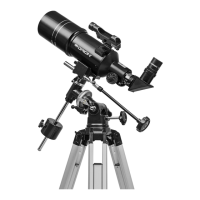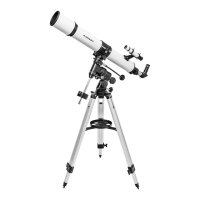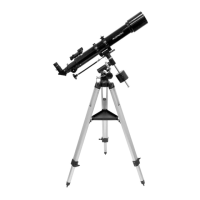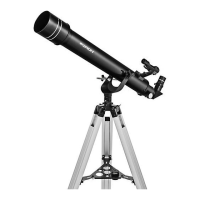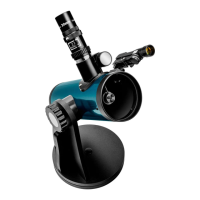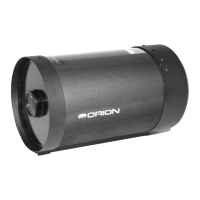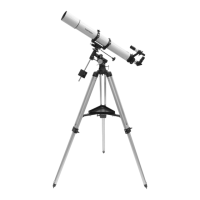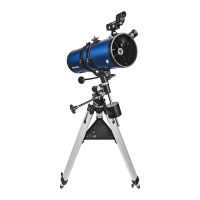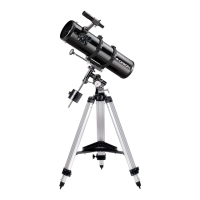12
V. Astronomical Observing
For many, this will be your rst foray into the exciting world of
amateur astronomy. The following information and observing
tips will help get you started.
Choosing an Observing Site
When selecting a location for observing, get as far away as
possible from direct articial light such as street lights, porch
lights, and automobile headlights. The glare from these lights
will greatly impair your dark-adapted night vision. Set up on
a grass or dirt surface, not asphalt, because asphalt radiates
more heat. Heat disturbs the surrounding air and degrades
the images seen through the telescope. Avoid viewing over
rooftops and chimneys, as they often have warm air currents
rising from them. Similarly, avoid observing from indoors
through an open (or closed) window, because the tempera-
ture difference between the indoor and outdoor air will cause
image blurring and distortion.
If at all possible, escape the light-polluted city sky and head
for darker country skies. You’ll be amazed at how many more
stars and deep-sky objects are visible in a dark sky!
“Seeing” and Transparency
Atmospheric conditions vary signicantly from night to night.
“Seeing” refers to the steadiness of the Earth’s atmosphere at
a given time. In conditions of poor seeing, atmospheric turbu-
lence causes objects viewed through the telescope to “boil.”
If you look up at the sky and stars are twinkling noticeably,
the seeing is poor and you will be limited to viewing at lower
magnications. At higher magnications, images will not focus
clearly. Fine details on the planets and Moon will likely not be
visible.
In conditions of good seeing, star twinkling is minimal and
images appear steady in the eyepiece. Seeing is best over-
head, worst at the horizon. Also, seeing generally gets better
after midnight, when much of the heat absorbed by the Earth
during the day has radiated off into space.
Especially important for observing faint objects is good
“transparency”—air free of moisture, smoke, and dust. All
tend to scatter light, which reduces an object’s brightness.
Transparency is judged by the magnitude of the faintest stars
you can see with the unaided eye (5th or 6th magnitude is
desirable).
Cooling the Telescope
All optical instruments need time to reach “thermal equilibri-
um.” The bigger the instrument and the larger the temperature
change, the more time is needed. Allow at least 30 minutes
for your telescope to acclimate to the temperature outdoors
before you start observing with it.
Let Your Eyes Dark-Adapt
Don’t expect to go from a lighted house into the darkness of
the outdoors at night and immediately see faint nebulas, gal-
axies, and star clusters—or even very many stars, for that mat-
ter. Your eyes take about 30 minutes to reach perhaps 80% of
their full dark-adapted sensitivity. As your eyes become dark-
adapted, more stars will glimmer into view and you’ll be able
to see fainter details in objects you view in your telescope.
To see what you’re doing in the darkness, use a red-ltered
ashlight rather than a white light. Red light does not spoil
your eyes’ dark adaptation like white light does. A ashlight
with a red LED light is ideal. Beware, too, that nearby porch,
streetlights, and car headlights will ruin your night vision.
Eyepiece Selection
Magnication, or power, is determined by the focal length of
the telescope and the focal length of the eyepiece being used.
Therefore, by using eyepieces of different focal lengths, the
resultant magnication can be varied. It is quite common for
an observer to own ve or more eyepieces to access a wide
range of magnications. This allows the observer to choose
the best eyepiece to use depending on the object being
viewed and viewing conditions. Your Observer EQ telescope
comes with 25mm (M) and 10mm (N) Plossl eyepieces, which
will suffice nicely to begin with. You can purchase additional
eyepieces later if you wish to have more magnication options.
Magnication is calculated as follows:
Telescope Focal Length (mm) / Eyepiece Focal Length
(mm) = Magnication
For example, the Observer 90mm EQ Refractor has a focal
length of 900mm, which when used with the supplied 25mm
eyepiece yields:
900mm / 25mm = 36x
The magnication provided by the 10mm eyepiece is:
900mm / 10mm = 90x
The maximum attainable magnification for a telescope is
directly related to how much light it can gather. The larger the
aperture, the more magnication is possible. In general, a g-
ure of 50x per inch of aperture is the maximum attainable for
most telescopes. Going beyond that will yield simply blurry,
unsatisfactory views. The Observer 134mm EQ has an aper-
ture of 134mm, or 5.3 inches, so the maximum magnication
would be about 265x (5.3 x 50). This level of magnication
assumes you have ideal atmospheric conditions for observing
(which is seldom the case).
Keep in mind that as you increase magnication, the bright-
ness of the object viewed will decrease; this is an inherent
principle of the laws of physics and cannot be avoided. If mag-
nication is doubled, an image appears four times dimmer.
If magnication is tripled, image brightness is reduced by a
factor of nine!
Start by centering the object you wish to see in the 25mm
eyepiece. Then you may want to increase the magnication
to get a closer view, by switching to the 10mm eyepiece. If
the object is off-center (i.e., it is near the edge of the eld of
view) you will lose it when you increase magnication, since
the eld of view will be narrower with the higher-powered
eyepiece. So make sure it is centered in the 25mm eyepiece
before switching to the 10mm eyepiece.

